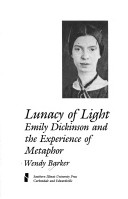"Are you afraid of the sun?" Emily Dickinson asked a friend in 1859.
Wendy Barker states here that that apparently casual query reveals a major theme of Dickinson s poetry, a theme she shares with women writers ranging from Anne Finch to Anne Sexton. It is a tradition based upon the inversion of the traditional male-centered metaphors of light and dark. Through time the light-giving sun has represented vitality, order, God; the light-swallowing night death, chaos, Satan. These metaphors are reinforced in the writing of Emerson, Thoreau, Hawthorne, and Keats, but Eliot, Bronte, Browning, and Dickinson use the sun and images of light quite differently.
Barker argues that since light was a masculine tradition, it had come to represent male power, energy, sexualitynot only to Dickinson but to other women writing during the era. To these writers the inversion of the light/darkness metaphor became a countertradition used as a means to express their energies in a society that was hostile to their intelligence. Dickinson, who read avidly, could not have been insensitive to this usage of light as a masculine symbolof her Calvinist God, of her father, of all that was maleand of darkness as a feminine symbol.
Emily Dickinson thought in a richly symbolic manner. Her most frequently used metaphor is one of light in contrast to darkness, employing single-word references to light more than one thousand times in her 1,775 poems. Barker offers close readings and new interpretations of some previously overlooked or misunderstood poems and demonstrates that "Many of her most ecstatic images are of little lights created from darkness." In answer to those critics who have characterized her poems as being piecemeal, Barker argues that Dickinson s consistent use of light as a metaphor unifies her poetry.
In her final chapter, Barker explores the ways in which twentieth-century female writers have carried on the countertradition of the light/darkness metaphor. "That Dickinson was able so brilliantly to transform and transcend the normative metaphoric patterning of her culture, creating, in effect, a metaphor of her own, has much to do with the genius of her art."
"
- ISBN10 0809313162
- ISBN13 9780809313167
- Publish Date 1 March 1987
- Publish Status Out of Print
- Out of Print 2 October 2008
- Publish Country US
- Imprint Southern Illinois University Press
- Format Hardcover
- Pages 214
- Language English
